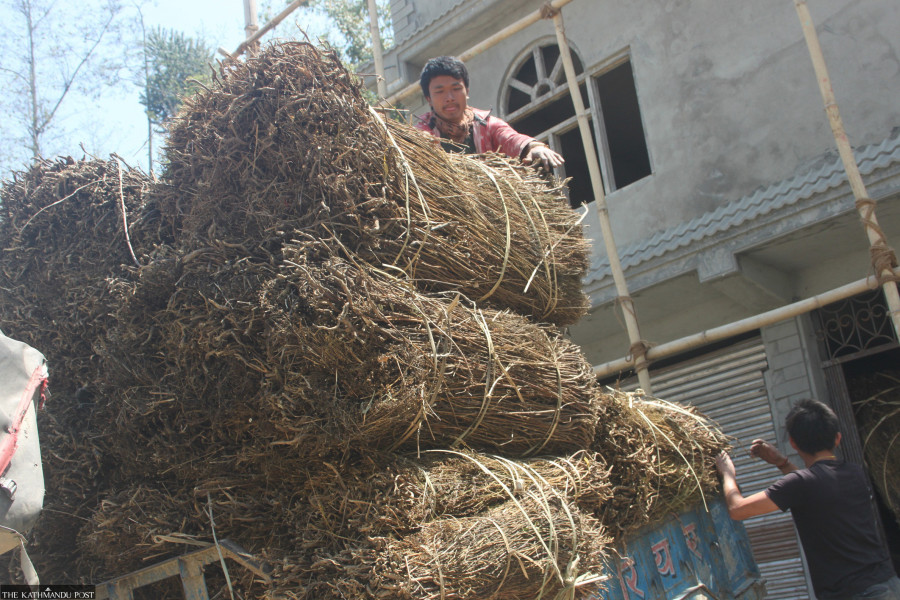Money
Chiraito traders clearing out stocks as Tibet market remains closed
Tibet is the largest buyer of the herb, but Chinese authorities do not plan to reopen the border anytime soon, insiders say.
Ananda Gautam
Traders in the eastern Himalayan district of Taplejung have started clearing out their Chiraito inventory after finding out that they will remain locked out of the Chinese market for some time.
Tibet is the largest buyer of the highly profitable medicinal plant (Swertia chirayita), but Chinese authorities do not plan to reopen the border anytime soon due to Covid-19, insiders said.
At this time of the year in the past, yak caravans would be hauling pack loads of the herb through Olangchung Gola to Tibet. Exports stopped since 2020 when the pandemic broke out, and the border with the northern neighbour was closed.
Chiraito prices have been fluctuating as per demand in China and India. Traders ship their products to either market whichever offers a higher price.
Chiraito is an integral part of Ayurved, Yunani, Chinese and Tibetan medication systems, and is also used in herbal medication systems in the United States and United Kingdom, according to a report. The whole plant is intensely bitter in taste.
With no sign of the border being reopened immediately by Chinese authorities, traders are bringing their products to the border markets of India to sell them.
Sabin Baniya of Sidingwa Rural Municipality, Sablakhu had gone to Olangchung Gola to sell Chiraito but had to return as there was no business to be done. He has been hoarding the herb at his house for two years to sell them in Tibet as he can get a better price there than in India.
A worried Baniya now plans to take his Chiraito to Kakarbhitta, adjacent to the Indian border town of Panitanki. He is studying the market price in India before making a final sales deal.
Other countries like Germany, Sweden, Italy, Holland and the United States also import the plant, but in small quantities.
Chiraito, also known as Chireeta, is a perennial wild herb which is now commercially cultivated in the high Himalayan ranges of Nepal, especially in the eastern part of the country.
Dried Chiraito is packed into 1 kg bundles of about 1 metre in length. According to a report, it is used as a tonic, febrifuge and antidiarrhetic, and also as a cure for various liver problems.
The plant is used to control the blood sugar level. The plant shows antipyretic, sudorific, antiperiodic, anthelmintic, anti-inflammatory and hepatoprotective actions, and is used in urinary and liver disorders
Rudra Adhikari, a trader from Panchthar district bordering Taplejung, has dispatched his Chiraito to Birtamod, Jhapa, the major market for mountain and hill districts like Taplejung, Panchthar and Ilam.
Adhikari has sold around 4,000 kg of Chiraito this year, and plans to sell another 4,000 kg. He is also buying the herb from other villagers.
According to Adhikari, Chiraito was mainly exported to India until a decade ago. At that time, growers used to get a maximum price of Rs200 per kg. Nepali traders turned their attention to China after Chinese traders started paying them more.
Traders then started exporting Chiraito to Tibet in large quantities, according to Baniya. The number of commercial growers also increased in the eastern mountain and hilly districts.
Demand for Chiraito increased so sharply that some traders were even shipping the herb by chartering helicopters from Sankhuwasabha. Chiraito grown in Taplejung and Ilam was carried to Sankhuwasabha, and then flown to Tibet by helicopter.
By 2015, the price had soared to Rs800 per kg. According to Hari Mishra, a trader from Birtamod who exports the herb to India, the price of Chiraito this year is Rs750 per kg. Adhikari said that he buys the plant at Rs600 per kg from Taplejung and Panchthar.
The freight charge from Taplejung to Birtamod is Rs50,000 per vehicle, traders said. A vehicle can carry 2,400 kg. Traders pay Rs5 per kg as export tax. Another tax of Rs15 per kg is imposed by the Division Forest Office.
Traders say that Chiraito has a huge export potential, but complain that the export process is more cumbersome than that of large cardamom.
The Division Forest Office issued permits to harvest 16,334 kg of Chiraito this year.
Sita Yogi, an official at the forest office, said that they had so far collected Rs245,000 in royalty. The herbs that grow wild for two years become ready for collection only in four years. In the first year, the stem does not grow and remains like a radish, but in the second year, the stem develops on the ground and it grows leaves and flowers and bears seedlings.
Farmers say that the plant grows up to 1.5 metres high in two years. Chiraito that grows with branches become ready to be harvested in four years as it also produces seeds.
Birendra Sah, a divisional forest officer, said that there are 27 species of Chiraito which are also divided into male and female.
The highest consumption of Chiraito is in Mumbai and Patna of India, said trader Mishra.
Chiraito of Taplejung was once considered to be of high quality, but lost its brand image due to mixing of male and female Chiraito along with other substances.




 16.09°C Kathmandu
16.09°C Kathmandu















